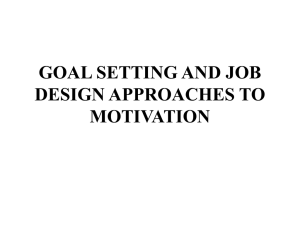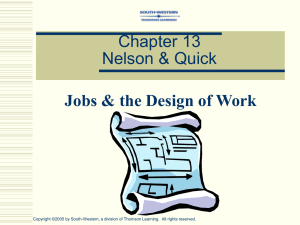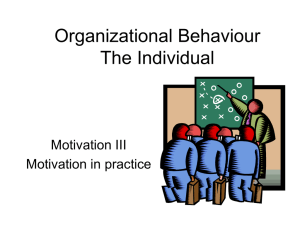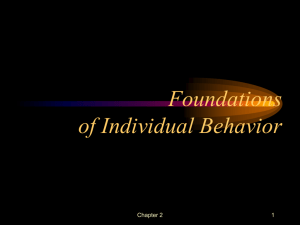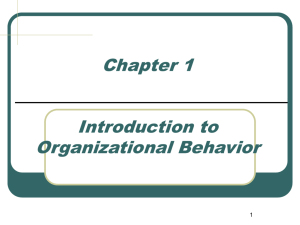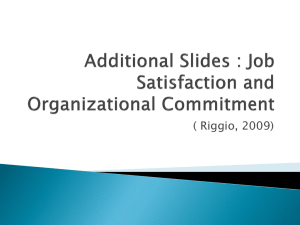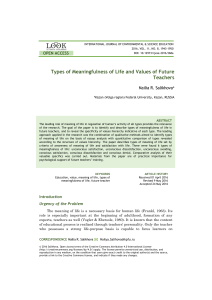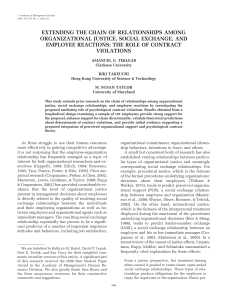GOAL SETTING AND JOB DESIGN APPROACHES TO MOTIVATION
advertisement
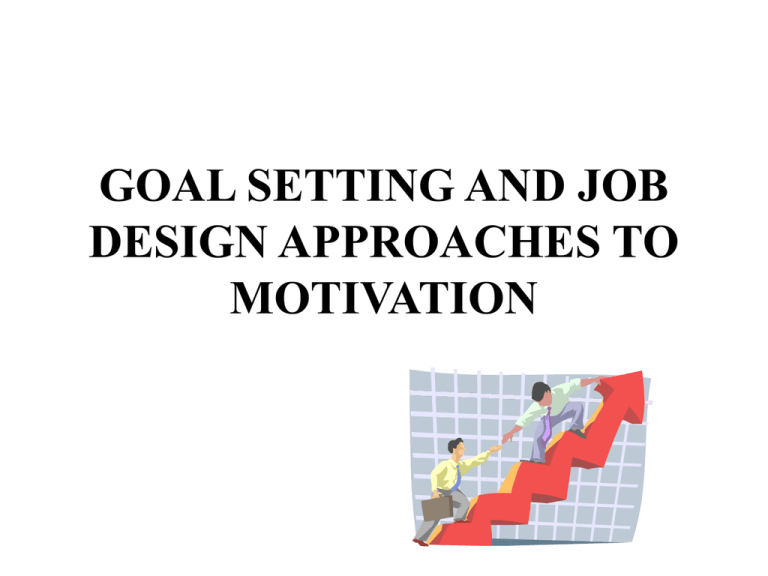
GOAL SETTING AND JOB DESIGN APPROACHES TO MOTIVATION MOTIVATIONAL FRAMEWORK Experienced need deficiencies Reassessment of need deficiencies Search for ways to satisfy needs Choice of goaldirected behaviors Experienced rewards or punishment Enactment of behavioral choice (performance) Goal Setting and Motivation • Goal setting is a useful method of enhancing employee performance. From a motivational perspective, a goal is a ____________________. • Goal setting, as a theory of motivation, assumes that behavior is a result of ________________ and _______________. Goals are useful for two purposes: • Goals provide a useful framework for managing motivation. Managers and employees can set goals for themselves and then work toward them. • Goals are an effective _________ device; control is monitoring by management of how well the organization is performing. GOAL SETTING: Four Key Parts • Goal Difficulty – Is the extent to which a goal is _____________ and requires effort. Difficult, yet realistic, goals are the most effective. • Goal Specificity – Is the ________ and _________ of a goal. Specific, rather than vague, goals are the most effective. GOAL SETTING: Four Key Parts • Goal Acceptance – Is the extent to which persons accept goals as their own. • Goal Commitment – Is the extent to which a person is personally interested in reaching a goal. The Goal-Setting Theory of Motivation Broader Perspectives on Goal Setting Overall Goals Subsidiary/Unit Goals Subordinate Goals Review and Revise Subordinate Goals Management By Objectives (MBO) •A collaborative goal-setting process through which organizational goals _______ down throughout the organization. •MBO programs help implement goalsetting theory on a systematic basis throughout the organization. Goal Setting and Motivation DO THESE IDEAS TRANSFER TO OTHER CULTURES? ARE DIFFICULTY, SPECIFICITY, ACCEPTANCE, AND COMMITMENT IMPORTANT IN ALL CULTURES? Job Characteristics Model Personal and Work Outcomes High internal work motivation High quality work performance High satisfaction with the work Low absenteeism and turnover Job Characteristics Model Three Critical Psychological States Experienced meaningfulness of work Experienced responsibility for work outcomes Knowledge of actual work results Personal and Work Outcomes High internal work motivation High quality work performance High satisfaction with the work Low absenteeism and turnover Job Characteristics Model Five Job Characteristics Skill variety Task identity Task significance Autonomy Feedback Three Critical Psychological States Experienced meaningfulness of work Experienced responsibility for work outcomes Knowledge of actual work results Personal and Work Outcomes High internal work motivation High quality work performance High satisfaction with the work Low absenteeism and turnover Job Characteristics Model Growth Need Strength Five Job Characteristics Skill variety Task identity Task significance Autonomy Feedback Three Critical Psychological States Experienced meaningfulness of work Experienced responsibility for work outcomes Knowledge of actual work results Personal and Work Outcomes High internal work motivation High quality work performance High satisfaction with the work Low absenteeism and turnover Job Characteristics Theory Core Job Dimensions •Skill Variety –The degree to which the job requires a variety of activities that involve different skills and talents. •Task Identity –The degree to which the job requires completion of a “whole” and an identifiable piece of work. –The extent to which a job has a beginning and an end with a tangible outcome. •Task Significance –The degree to which the job affects the lives or work of other people, both in the immediate organization and in the external environment. Job Characteristics Theory: Core Job Dimensions • Autonomy – The degree to which the job allows the individual substantial freedom, independence, and discretion to schedule the work and determine the procedures for carrying it out. • Feedback – The degree to which the job activities give the individual direct and clear information about the effectiveness of his or her performance. Job Characteristics Theory: Critical Psychological States •Experienced meaningfulness of the work –The degree to which the individual experiences the job as generally meaningful, valuable, and worthwhile. •Experienced responsibility for work outcomes –The degree to which individuals feel personally accountable and responsible for the result of their work. •Knowledge of results –The degree to which individuals continuously understand how effectively they are performing their job. Job Characteristics Model Growth Need Strength Five Job Characteristics Skill variety Task identity Task significance Autonomy Feedback Three Critical Psychological States Experienced meaningfulness of work Experienced responsibility for work outcomes Knowledge of actual work results Personal and Work Outcomes High internal work motivation High quality work performance High satisfaction with the work Low absenteeism and turnover JOB DESIGN ACROSS CULTURES • WHAT ARE THE KEY PARTS OF THIS APPROACH THAT WILL DETERMINE WHETHER OR NOT THIS APPROACH WILL WORK IN OTHER CULTURES? • DESIRE FOR CORE JOB DIMENSIONS? • CRITICAL PSYCHOLOGICAL STATES? • IMPORTANCE OF GROWTH NEEDS? MOTIVATIONAL FRAMEWORK Experienced need deficiencies Reassessment of need deficiencies Search for ways to satisfy needs Choice of goaldirected behaviors Experienced rewards or punishment Enactment of behavioral choice (performance)
